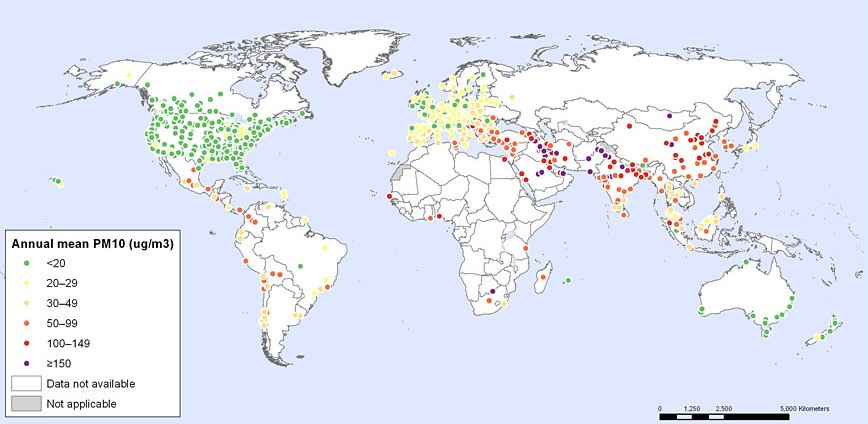World Health Organization has issued a new report on the health effects of particulates (the small unburned particles released when fossil fuels and biomass are burned).

Map of air pollution levels in cities with population over 100,000 and capital cities
larger image
WHO says:
• Indoor air pollution is estimated to cause approximately 2 million premature deaths mostly in developing countries. Almost half of these deaths are due to pneumonia in children under 5 years of age.
• Urban outdoor air pollution is estimated to cause 1.3 million deaths worldwide per year. Those living in middle-income countries disproportionately experience this burden.
From the report:
PM10 particles, which are particles of 10 micrometers or less, which can penetrate into the lungs and may enter the bloodstream, can cause heart disease, lung cancer, asthma, and acute lower respiratory infections. The WHO air quality guidelines for PM10 is 20 micrograms per cubic metre (µg/m3) as an annual average, but the data released today shows that average PM10 in some cities has reached up to 300 µg/m3.
The 1 1/3 million who died from outdoor air pollution in 2008 is an increase of 200,000 over the 2004 estimate (due to increases in air pollution and numbers living in urban areas, as well as improved data). The recommended level of 20 µg/m3 is better, but not healthy: 250,000 people would have died if particulate pollution everywhere stayed below that level.
In both developed and developing countries, the largest contributors to urban outdoor air pollution include motor transport, small-scale manufacturers and other industries, burning of biomass and coal for cooking and heating, as well as coal-fired power plants. Residential wood and coal burning for space heating is an important contributor to air pollution, especially in rural areas during colder months.
Measurements were made in 2003 – 2010; the majority were from 2008 – 2009.
WHO also discusses other pollutants, such as ozone, NO2 and SO2, but gives mortality in a different format:
Ozone
…
Excessive ozone in the air can have a marked effect on human health. It can cause breathing problems, trigger asthma, reduce lung function and cause lung diseases. In Europe it is currently one of the air pollutants of most concern. Several European studies have reported that the daily mortality rises by 0.3% and that for heart diseases by 0.4 %, per 10 µg/m3 increase in ozone exposure.Nitrogen Dioxide
…
Epidemiological studies have shown that symptoms of bronchitis in asthmatic children increase in association with long-term exposure to NO2. Reduced lung function growth is also linked to NO2 at concentrations currently measured (or observed) in cities of Europe and North America.Sulfur Dioxide
…
SO2 can affect the respiratory system and the functions of the lungs, and causes irritation of the eyes. Inflammation of the respiratory tract causes coughing, mucus secretion, aggravation of asthma and chronic bronchitis and makes people more prone to infections of the respiratory tract. Hospital admissions for cardiac disease and mortality increase on days with higher SO2 levels. When SO2 combines with water, it forms sulfuric acid; this is the main component of acid rain which is a cause of deforestation.

